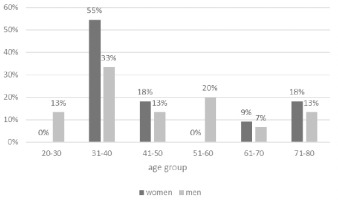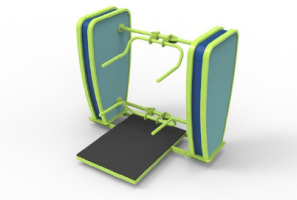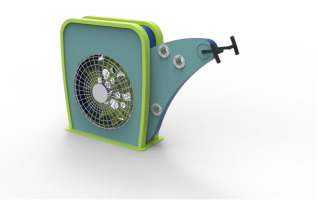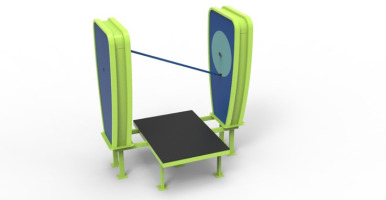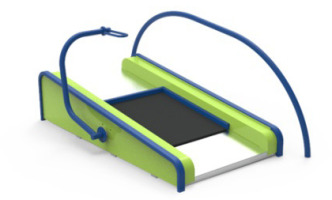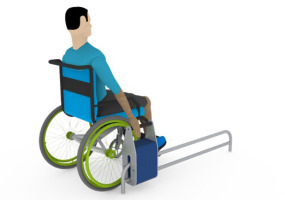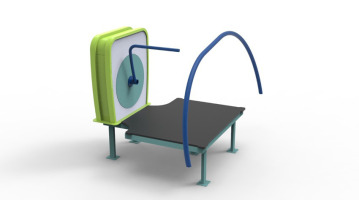Introduction
Physical activity significantly contributes to maintaining good health, especially in the physical, mental and social aspects. The changes that occur in the human body during physical activity determine the functional efficiency of the human body. This, in turn, minimizes the risk of many diseases and dysfunctions. The beneficial effect of physical activity on human health has been repeatedly confirmed by numerous studies [1,2]. An active lifestyle is one of the main factors influencing the prevention of metabolic diseases (overweight, obesity, diabetes), diseases of the cardiovascular, digestive, musculoskeletal, respiratory, nervous and endocrine systems [3]. Regular physical activity affects the body’s performance, shapes motor skills, and affects the quality of sleep and brain functions. It is also one of the most effective methods of preventing cognitive disorders and lifestyle diseases, such as coronary heart disease, hypertension, diabetes, and cancer. Systematically undertaken physical activity leads to several positive changes that have a comprehensive impact on the human body. One of the most obvious is the impact of physical activity on the human musculoskeletal system. The locomotor system is inextricably correlated with the vascular and respiratory systems. As a result of regular physical activity, an increase in bone mass, its density, strength and elasticity, an increase in muscle mass [4], and an increase in the number of muscle motor units and mitochondria are observed. Research has shown that systematic physical activity has a beneficial effect on the immune system [5]. It reduces the risk of infection by stimulating the production and mobilization of immune cells that are involved in, among others: in combating infectious diseases. In the case of the nervous system, regular physical activity improves: motor coordination, mental concentration and, memory [6], proprioception, speed of reaction to stimuli, and static and dynamic stabilization. It also increases cognitive abilities [7] and delays the development of many neurodegenerative diseases [8]. The most characteristic changes in the respiratory system as a result of physical activity focus on increasing the vital capacity of the lungs, increasing chest mobility and improving gas exchange [9]. In turn, in the case of the circulatory system, physical activity contributes to: improving the elasticity of arteries, increasing cardiac output, improving the functioning of the muscle pump, increasing blood supply to the heart and maximizing oxygen saturation [10]. It is certain that physical activity is beneficial for the cardiovascular system because it reduces the risk factors for cardiovascular diseases [11]. In relation to the digestive system, physical activity improves digestive functions and intestinal peristalsis. It also has a preventive effect on reducing the risk of colorectal cancer [12]. It increases the absorption surface and blood supply to the viscera.
Considering the above, the priority in striving for the proper quality of life of people with special needs, in particular with mobility disabilities, is to provide this population with the opportunity to participate in sports activities and access to devices in order to undertake physical activity tailored to their individual needs [13,14]. The designed devices should be available in publicly accessible activities and recreation zones. The population of people with disabilities is small compared to people with full mobility and who are healthy or apparently healthy. Therefore, the optimal solution is to create devices for physical activity intended for both able-bodied and disabled people. Through jointly undertaken activities, the social integration role of recreation places will also be fulfilled. This, in turn, will contribute to counteracting the exclusion of people with disabilities. However, the main task of exercise equipment is to maintain health at a given, desired level. Small sports and recreational infrastructure facilities intended for young people and adults allow you to actively spend your free time outdoors, with family, friends and acquaintances. The location of the facilities is usually green areas, which additionally provides landscape values. The local community treats them as a meeting place, and uses them for selected elements of training or warm-up while practicing other sports.
Aim of the work
Research objectives:
learning about the limitations and barriers to physical activity among people with disabilities, regarding places to engage in physical activity, taking into account their integration and social role;
determining the needs and capabilities of people with special needs in relation to places of activity;
presenting proposals for innovative exercise equipment, the so-called an integrated outdoor gym, adapted to people with mobility disabilities.
Material and methods
The research material for this pilot study consisted of data obtained from 26 people with motor disabilities and other accompanying chronic diseases (arterial hypertension, obesity, insulin-dependent diabetes, parkinsonism, epilepsy, degenerative joint diseases, heart diseases, atherosclerosis, Alzheimer’s disease, depression, hearing loss, vision disorders). The research was conducted among residents of a social welfare home in Szczecin, Poland. The project implementers provided the printed questionnaires through the employees of the Social Welfare Home. The respondents constituted 25% of all residents of the Social Welfare Home. The criteria for exclusion from the study included lack of consent to participate in the study and categories of disability other than physical ones. The limitations of the research were: a small group of respondents, difficulties in access to the research group staying in the Social Welfare Home, the independence of the respondents when completing the questionnaires, the degree of disability that allowed the use of devices. Disabilities in the study group were most often a consequence of ischemic and hemorrhagic stroke. The ages of the respondents ranged from 28 to 73 years. 11 women and 15 men participated in the study (Figure 1). Residents of the Social Welfare Home participate in rehabilitation activities conducted at the facility, but are not able to take part in outdoor activities. The research group included residents of a social welfare home in Szczecin who expressed their willingness and consent to participate in physical exercises on innovative outdoor gym equipment.
The diagnostic survey method and survey technique were used, and the tool was a self-authored questionnaire containing questions about sociodemographic features such as gender and age, the frequency of leaving home, including independence, the purpose of leaving home, limitations and barriers to taking up physical activity, and knowledge of the offer of places for physical exercise, entertainment and training and their use as well as the needs and physical capabilities of the examined people with special needs. Exercise equipment for people with physical disabilities was also presented, which is innovative and provides a place for exercise and social integration. The obtained data were subjected to simple statistical analysis. The data was presented in graphical and descriptive form.
Proposed devices, The Gateway, Handbike, Kayaker, Platform, Farmer’s Walk and Rower (Figures 2-7), enable people with special needs to engage in physical activity. The devices are intended for exercising upper muscle groups and are adapted for people with disabilities. They are used in medical rehabilitation. As a result of the greater dynamics of exercise, the resistance increases. To make it easier for users to use, the device manual contains boards with pictograms, interactive boards with instructional videos and an audio board.
Results
The obtained results provided answers to the formulated research problems. The research was conducted among people who, in accordance with the Polish system based on the Act on Vocational and Social Rehabilitation and Employment of Disabled Persons [15], have a disability category: physical. This category includes people with damage to the musculoskeletal system. All respondents said they needed someone to help them when they left home. At the same time, they indicated doctor visits or rehabilitation as the main reason for leaving home. The frequency of leaving home is shown in Table 1. 42.3% (n=11) of respondents leave home less than once a week.
Table 1
Frequency of respondents leaving home depending on gender
| Frequency of leaving home | Population | Women | Men | |||
|---|---|---|---|---|---|---|
| n | % | n | % | n | % | |
| Every day | 2 | 7.7 | 1 | 9.1 | 1 | 6.7 |
| A few times a week | 10 | 38.5 | 5 | 45.5 | 5 | 33.3 |
| Once a week | 3 | 11.5 | 2 | 18.2 | 1 | 6.7 |
| Less than once a week | 11 | 42.3 | 3 | 27.3 | 8 | 53.3 |
None of the surveyed people knows any sports, entertainment or training offers for people with disabilities in their area and none of them use such offers. Most of the surveyed people (69%) (n=18) had never been to a public recreation place (recreation site, ”open-air gym”) where there were facilities for people with disabilities. Only 23% (n=6) of respondents from this group used such devices, and 62% (n=16) of those who used them liked this form of exercise, relaxation and fun. At the same time, the respondents did not find any barriers that they could not overcome in such a place. Only 12% (n=3) of people found themselves in a situation where a specialist (trainer, rehabilitator or physiotherapist) conducted classes with people with disabilities on devices intended for such people in the field.
All respondents showed interest and declared that they would attend a place (if it were created) that was publicly accessible, free of charge, without barriers and equipped with devices for people with disabilities, namely, one where you could perform recommended physical activity, improve your range of motion, learn or improve the performance of complex everyday activities. Most respondents would like to use such places several times a week (62%; n=18) or once a week (35%; n=9), and only 4% (n=1) declare that they could, but rather occasionally, less than once a week. All respondents unanimously declared their desire for such places to be created next to existing recreation areas, where people with disabilities could spend time with the non-disabled population. As amenities in such places, 42% (n=11) of respondents expected an adapted toilet, 23% (n=6) the presence of a caregiver, and 19% (n=5) expected specialized equipment and a safe surface. More than half of the respondents (58%; n=15) indicated a nearby parking lot as a convenience, and 46% indicated a shelter allowing shelter from unfavorable weather conditions as a convenience when visiting such a place. 38% (n=10) did not indicate any required amenities that would condition their use of such places.
Discussion
The obtained results show problems with the everyday functioning of people with disabilities. They usually leave home only when it is necessary and to visit a specialist or a rehabilitator. The respondents need the help of their loved ones. Therefore, they probably no longer think about additional entertainment or sports activities, because it exceeds their functional capabilities. However, as research has shown, under favorable conditions, all respondents would be very interested in taking up physical activity. Respondents also pointed out the lack of places where people with disabilities can exercise. The availability of devices designed by TLS Sport can change the lifestyle and functioning of people with disabilities.
People with special needs, just like able-bodied people, associate taking up physical activity with the hope of improving their well-being, health and appearance. Cycling, jogging and walking are popular among Polish society. People with mobility disabilities, especially those in wheelchairs, are unable to undertake many activities. The solution is outdoor gym equipment specially dedicated to them, where they can develop their fitness at any time.
Globally, the need for physical activity affects approximately 1.5 billion people with physical, mental, sensory or intellectual disabilities [16]. This population is more exposed to the negative consequences of lack of physical exercise than healthy people. Meta-analyses have shown that physical activity has beneficial effects on cardiovascular fitness, musculoskeletal fitness, brain function and mental health [17-19]. They also show that these benefits can be achieved even with less than 150 minutes of physical activity per week. Therefore, actions taken to help people with disabilities in their pursuit of physical activity should be intensified. The National Multiple Sclerosis Society of the USA has issued recommendations promoting the benefits of exercise for everyone with multiple sclerosis. It found that health care professionals should recommend more than 150 minutes of physical exercise per week. Progress in this area should be gradual and be based on the individual’s skills, preferences and safety. When physical mobility is very limited, exercises should be facilitated by a trained assistant [20].
Physical activity in older people has a preventive effect on reducing disability. Comparative data from the Lifestyle Interventions and Independence for Elders study showed that the two study groups decreased their quality of life in direct proportion to age, while the group engaging in recommended physical activity showed a slower decline in health-related quality of life [21].
The health benefits of regular recreational physical activity are recognized as a means of minimizing the health effects of a sedentary lifestyle in the general population. However, people with physical disabilities participate in recreational activities less often than healthy people. Although research on the impact of recreational physical activity on the quality of life in the population of people with disabilities is limited, it has been shown to be positively associated with improving the quality of life, life satisfaction, health, social mood and employment of people with disabilities. Unfortunately, people with disabilities encounter numerous barriers when undertaking various forms of activity, such as: availability of exercise equipment, transport, awareness, finances and cognitive disorders [22]. Most people with physical disabilities do not practice sports regularly, which may increase the risk of developing secondary diseases. A literature review study on barriers and facilitators to participation in sports among people with various physical disabilities showed that personal barriers included disability and health. Environmental barriers included the lack of transport infrastructure and difficulties with access to exercise equipment [23]. The research conducted by Matsuda et al. [24] aimed to determine whether there are differences in the level of physical activity of people with various disability-related conditions, as well as to examine whether the fear of falling is associated with physical activity, in people who are aging, with long-term disability. The main variables in the study were physical activity, its intensity and fear of falling. Differences were found between diagnostic groups in terms of physical activity undertaken. Also, fear of falling was associated with physical activity. In turn, the research of Zahra et al. [25] aimed at analyzing the differences between taking up physical activity and a passive attitude among people with and without disabilities and its relationship to the psychological quality of life. The study population included 359 participants with and without disabilities. Respondents without disabilities reported significantly better psychological quality of life compared to those with disabilities. A significant difference was found between the quality of life after a long time without physical activity among people with disabilities compared to non-disabled people. The level of physical activity was associated with better quality of mental life in healthy people. It has been shown that the longer the time of passive sitting, the worse the psychological quality of life among the respondents.
Research by Bouzas et al. [26] aimed to determine whether amputees participating in a physical training program could benefit from improved health demonstrated by physiological performance and level of functionality. It was shown that the exercises had a positive effect on the parameters of aerobic and muscular performance. It was also shown that combined exercises for muscular endurance and functional physical exercise had a greater positive impact on cardiorespiratory fitness, muscle fitness and the level of functioning in the study population. Stroke survivors with limited mobility do not and will not meet the recommended standards for engaging in physical activity to achieve health benefits [27]. Therefore, there are dedicated exercise equipment with appropriate wheelchair platforms for such people. Research conducted by Jackson et al. [28] showed that almost half of the study group reported low levels of physical activity. The respondents reported numerous, interrelated and overlapping personal, interpersonal and environmental barriers that make it difficult to engage in physical activity. The physical activity of people with neuromusculoskeletal disorders in the research of Newitt et al. [29] had: imbalance in walking, muscle weakness, pain, stiffness, urinary tract health problems, depression, thermoregulation disorders and fear of injury. The main motivators to take up activity were: increasing independence, losing weight and preventing secondary diseases. The main environmental barriers limiting activity are: low availability of devices, high transport costs, and lack of support from health care workers. The most common personal demotivators are: lack of motivation, feeling embarrassed in public places, anxiety, frustration, and anger. Subsequent studies indicate the impact of physical activity on physical, mental and social health, but also, as the authors emphasize, on the neurohealth of people with disabilities [30]. Other studies aimed to find out the opinions of people with physical disabilities on environmental activities aimed at increasing physical activity in this population [31]. Semi-structured interviews were conducted with 21 people with physical disabilities and the responses were analyzed using thematic analyses. The data were interpreted using an integrated model for mapping the physical activity of people with disabilities, and the results obtained indicate that environmental activities should be aimed at stimulating internal motivation and increasing the awareness of the health effects of physical activity. The actions taken should aim to provide a variety of classes, increase their availability, during individual coaching sessions as well, present role models and provide care during exercises. Intermediary organizations, social media and word-of-mouth promotion also play an important role here. The costs of exercise should be financed by the government, sponsors and health insurers. Limitations in research are related to limited access to people with disabilities. Therefore, the representativeness of the sample is low. The assistance of other people is needed when completing the research tools.
Conclusions
The obtained research results indicate low physical activity of the respondents, probably resulting from significant mobility limitations, lack of independence, and lack of available infrastructure adapted to exercise near their place of residence. There is a great demand for the development of sports and recreational infrastructure while maintaining all aspects of respect for people with disabilities. The versatility of outdoor exercise equipment allows you to create perfect places for integration and social bonding. Currently existing physical activity spaces do not meet this goal. On the contrary, they are an example of marginalizing the needs of people with disabilities. People with various types of disabilities also include older people. Polish and European society is aging, so paying attention to the functioning of people with special needs is becoming a priority. Physical activity of adults with disabilities may originate in earlier periods of ontogenesis, so a positive attitude and availability of exercise equipment are already needed in adolescence [32]. Healthy lifestyle programs can reduce barriers to participation as well as increase physical activity, improve healthy lifestyle habits, and facilitate social integration. The conducted pilot research requires continuation due to the need to raise public awareness of the importance of physical activity for all population groups, especially people with disabilities.








